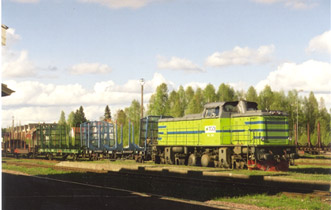
A TGOJ T43 resting for the weekend in Orsa, August 2001. See more in Ollies trainstuff!, all colorphotos by Ollie Ahokas
J Class tanks

One of the survivers of J-class is hauling tourists on the preserved line of Skanska Jarnvagar.
They have a very nice webpage, on fortunally only Swedish.
Photo by: Skanska Jarnvagar.
The tank engines of J-class engines were designs for local passenger runs. It was equipped with inside cylinders and was superheated. The design was successful and 46 engines of the class were built The class were designed as a midsize tank engines to run on light track, like the branch lines in north, therefore the engines equipped rather large coal- and water tanks, also it was required to the top speed backwards matched with running boiler end first. The class was the first and the smallest of successful series of engines with this wheel configuration, followed by Sb-class (reclassified as S2) and the very last class of Swedish steam the S1 dating 1952. During the WWII, some engines were armour plated, but post war the engines were restored to their original appearance. 1914 Motala Verkstad produced the first five engines and they were given the numbers 1233-1237. Atlas Verkstäder, in Stockholm built 10 engines, No. 1915-1916 and NOHAB in Trollhättan No. 1291-1295 in 1917. But the majority of the engines were constructed by Motala Verkstad, like the pictured engine No. 1393 (1918) on the Brösarp-St. Olof preserved line.